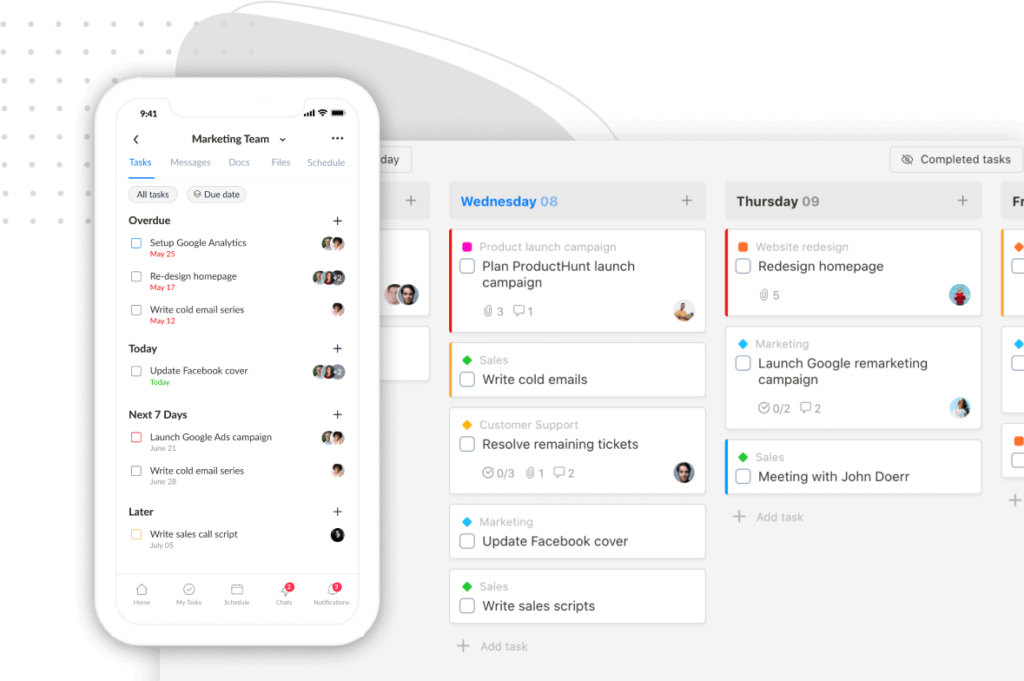Searching for Todoist vs Things 3 comparisons? Well, you’re in the right place! Take a look at this table:
|
Things 3 |
Todoist | |
|---|---|---|
|
Free version |
✅ | |
|
Price range |
$10-$50 (one-time purchase) |
$4-$8 (per-user purchase) |
|
Platform |
-iOS, Mac, & iPad -Apple Watch |
-iOS, Mac, & iPad -Apple Watch -Android -Windows -Web |
(This is a quick overview of the two task management apps; I’ll show you detailed comparisons between them later.)
From the table, we notice three quick caveats about Things 3:
- No free version
- No web app
- Only available on Apple devices
So, whether you’re looking for a free to-do list app or you want to connect your task manager to other non-Apple devices or platforms, Things 3 is not for you. You should opt for Todoist.
But if you’re already inside the Apple ecosystem or planning to, plus you have a flexible budget, the following Things 3 vs Todoist comparison will help you figure out which to-do app is right for your needs.
II. Todoist vs Things 3: Feature Comparisons
1. Task Capture Process
Efficiently capturing tasks is at the core of any good to-do list apps. So, let’s explore how Things 3 and Todoist streamline the task capture process.
A. Capturing Tasks in Things 3
i. “Quick Entry” Feature
The task manager app offers a feature called “Quick Entry” that simplifies the task entry process. It allows you to swiftly create tasks without having to navigate through the app’s interface extensively. Here’s how it works:
-Press Ctrl-Space to invoke the Quick Entry window.
-Enter your task title, such as “Pick up dry cleaning”, and other details
-Click “Save”, and your task is seamlessly added to the relevant to-do list.
ii. Natural Language Input
Things 3 allows you to use your everyday language to quickly set deadlines, add reminders, or schedule tasks.
For example, to set a due date to the task “Book flights”, click/tap to open the task, click the flag icon, type the deadline, and enter.
B. Capturing Tasks in Todoist
i. “Quick Add” Feature
The task management app offers a similarly efficient task entry process called “Quick Add”:
-Click the “+” symbol to open the Quick Add window.
-Type in the task title, e.g., “Buy groceries on Saturday”, and add other details.
-Press “Add task”.
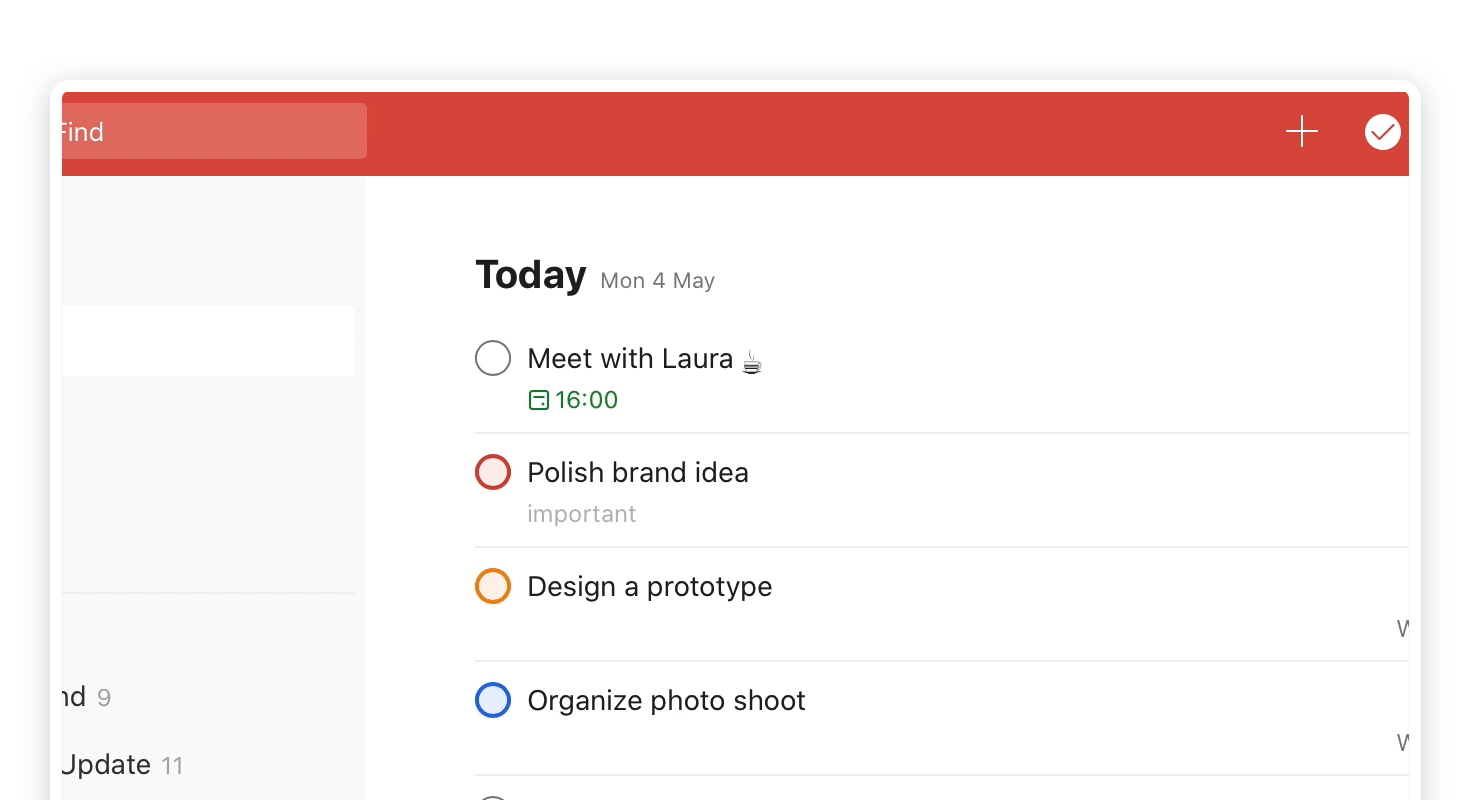
ii. Natural Language Processing (NLP)
In general, Todoist’s NLP capabilities are more robust.
With Todoist, you can use your everyday language to set due times, set priorities, add labels, add tasks to a project or section, and assign tasks to a collaborator.
But you can’t do these in Things 3. Its NLP feature only supports setting start and due dates and adding reminders.
Take an example.
If you want to create a high-priority task for a meeting today at 9:30AM and you want the Todoist app to remind you 30 minutes before the meeting, type “Meeting with Ada tod 9:30 !30min p1”.
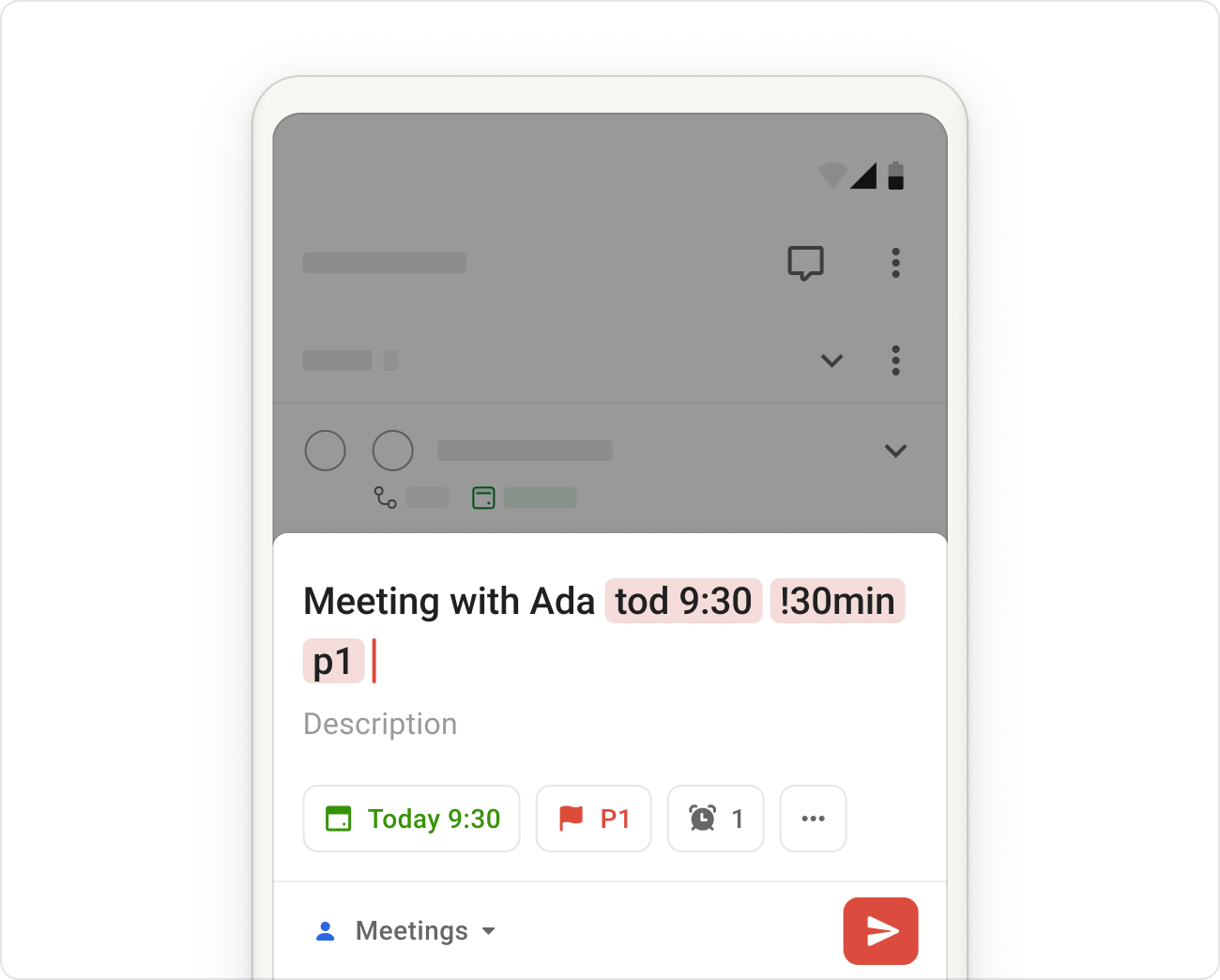
C. Mobile Task Capture
Both task manager apps recognize the importance of task capture on mobile devices. They offer the convenience of adding tasks on-the-go, ensuring you never miss a beat.
2. Task Management
A. Task details
Compared side by side, Todoist provides a broader range of task detail features.
You’ll find in Todoist many advanced task features that Things 3 doesn’t offers, including:
- Due times
- Priorities
- Assignees
- File attachments
Todoist also allows you to share tasks and work together with team members.
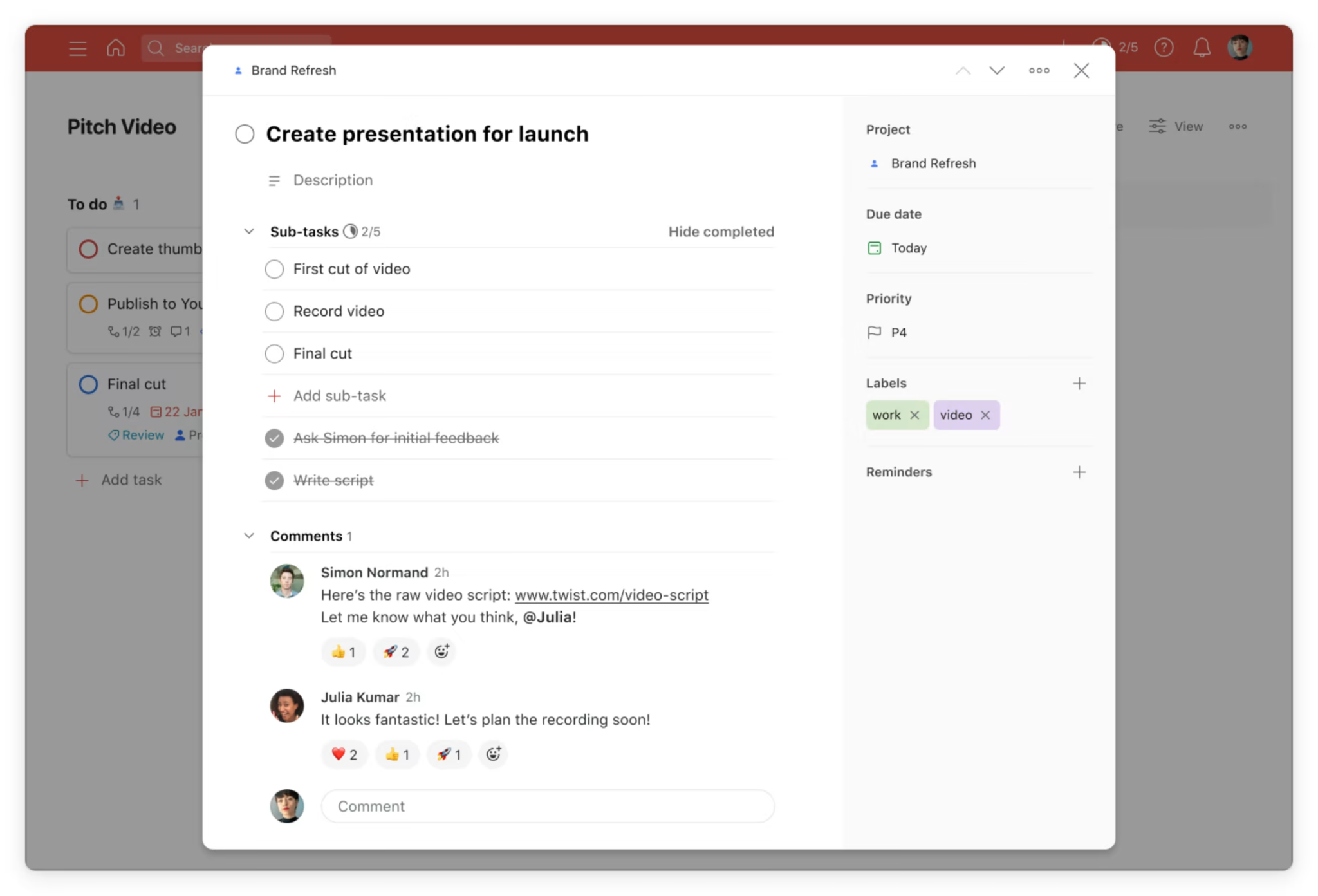
Things 3, on the other hand, excels in simplicity and offers a straightforward approach.

Another noteworthy difference is in how they handle sub-tasks.
Both task managers allow you to create sub-tasks, but Things 3 treats them as checklist items within tasks, whereas Todoist allows you to create nested sub-tasks.
This highly structured approach makes it easy to break down complex tasks into smaller, more manageable chunks.
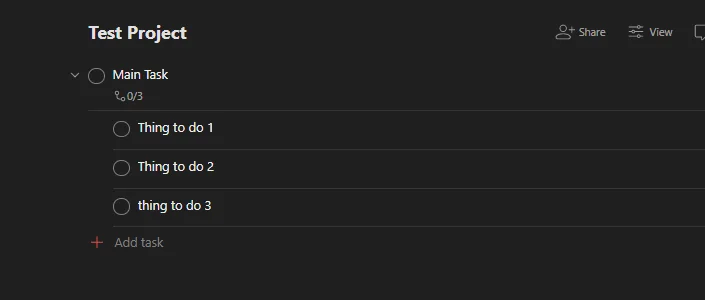
Here’s a Things 3 vs Todoist comparison in terms of task details:
|
Things 3 |
Todoist | |
|---|---|---|
|
-Titles -Notes -Due dates -Tags -Subtasks -Comments -Recurring tasks -Push notifications |
✅ |
✅ |
|
Start dates |
✅ | |
|
Time-based reminders |
✅ |
✅ |
|
Location-based reminders |
✅ | |
|
Due times |
✅ | |
|
Assignees |
✅ | |
|
Priority settings |
✅ | |
|
Attachment |
✅ |
B. Managing tasks from emails
In the realm of task management, efficiently converting emails into actionable to-dos can be a game-changer.
Both Things 3 and Todoist provide effective ways to manage all the tasks derived from emails, but they do so through different approaches:
i. Things 3
This task manager offers a straightforward approach: Just send or forward emails to your @things.email address, and they’ll appear as tasks in your Inbox, automatically extracting relevant details:
- Email subject -> Task title
- Email body -> Task note
- File attachments are ignored.
This method is ideal for those who prefer a clean and minimalistic task input process.
ii. Todoist
This task manager provides a more flexible solution, allowing you to send or forward emails to a specific project or task.
Additionally, it can transform email attachments into task attachments.
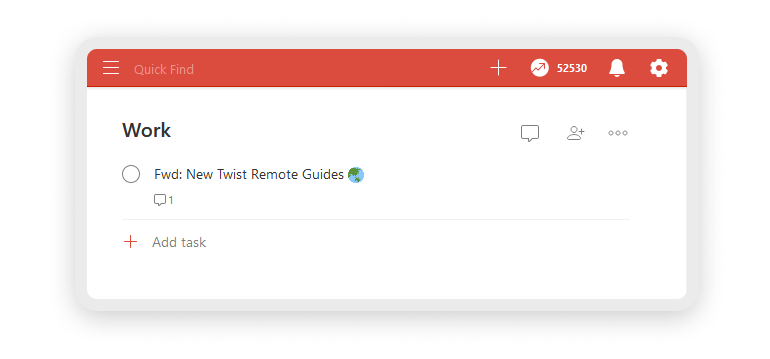
C. Filtering & sorting options
Todoist, once again, wins.
While Things 3 only allows for filtering tasks by tags, Todoist offers multiple options to sort, filter, and group tasks.
Specifically, it enables you to:
- Sort tasks by due date, priority, project, date added, assignee, or name
- Create custom filters to see only the tasks you want to see at the moment.
- Select from the two layout options (list or board).
3. Planning & Scheduling
Next, let’s explore how Todoist and Things 3 help you plan your daily tasks.
A. Date management
Both task managers support due dates, showing you when tasks should get done. But they each have their own cool tricks.
With Things 3, you can set a start date. It’s like saying, ‘Hey, I’m gonna start on this task now,’ which can be super handy for planning and time-blocking your day.
Todoist takes a different route.
It gives you priorities (!1, !2, !3) to show how important tasks are and labels to easily batch similar tasks together.
B. Task planning approach
When it comes to task planning, Todoist and Things 3 uses distinct approaches.
i. Things 3
The task manager goes for a cool four-view approach:
- “Someday” – where you stash tasks that aren’t important and don’t have specific dates.
- “Anytime” – a place for important tasks that also don’t have specific dates.
- “Today & This Evening” – for due or scheduled tasks on the current day. If you set a start date for today, it shows up in “Today,” and if you’re planning to do stuff later in the day, that’s what “This Evening” is for.
- “Upcoming” – keeps track of upcoming tasks in the next seven days or even months ahead.
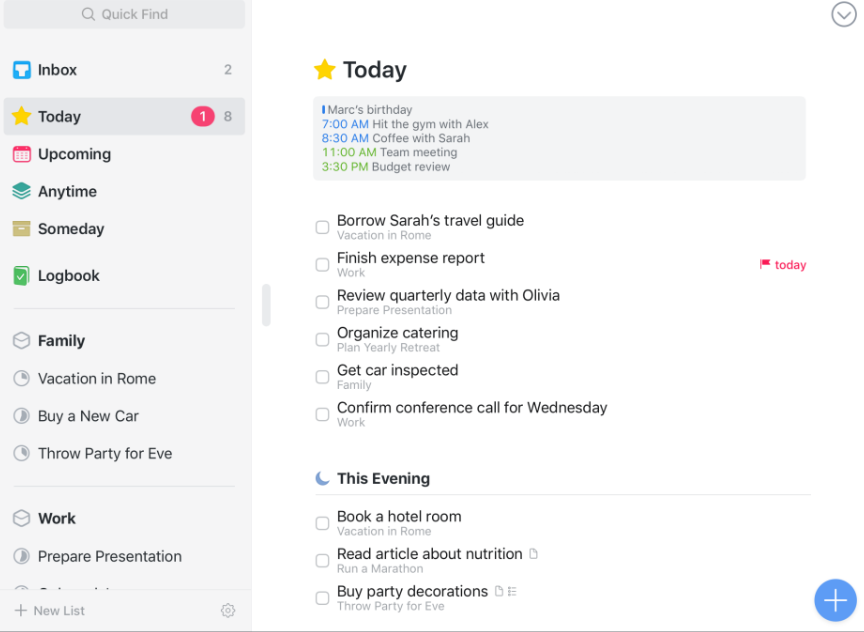
ii. Todoist
Now, this task manager takes a simpler three-view approach:
- “Inbox” – it’s like the default inventory for all your new tasks. You don’t need to categorize them right away; you can sort them out later into projects and schedules.
- “Today” – a place where you find tasks due or scheduled for the current day. You can also reschedule multiple tasks for the current day or postpone them to a later date if needed.
- “Upcoming” – helps you preview and manage tasks due in the next week or beyond. And the cool part? You can just drag and drop tasks to reschedule them.
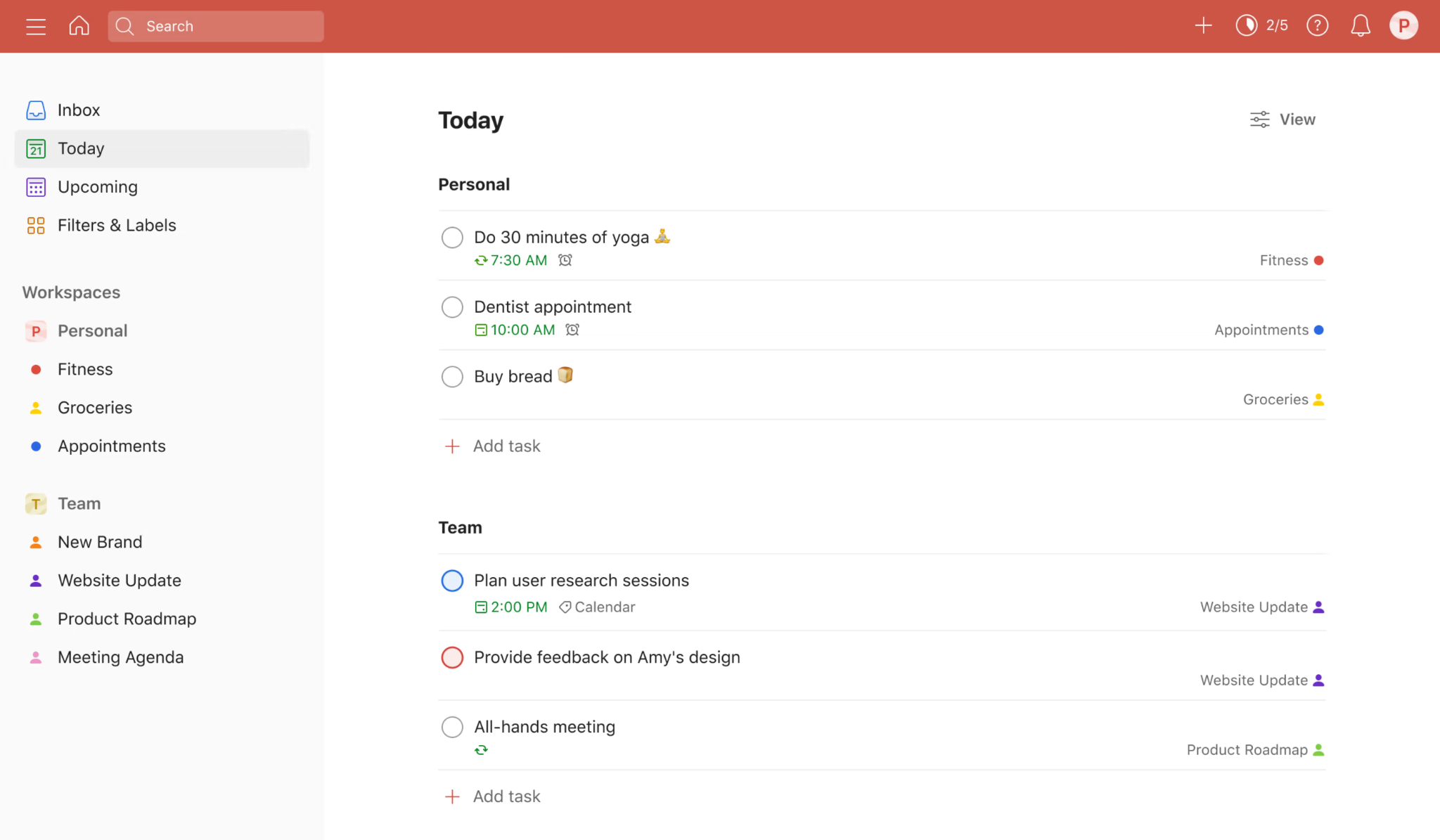
In comparison, Things 3 keeps things structured for proactive planners, while Todoist is all about flexibility, making it easy to reschedule and stay on top of things.
C. Calendar integration
i. Things 3
Designed as an Apple-ecosystem-only app, it’s no surprise that Things 3 offers deep integration with Apple Calendar.
Once you’ve completed the initial setup, Things 3 will automatically sync up with your Apple Calendar, displaying all calendar events in its “Upcoming” view.
There’s an exclusive advantage for Mac users: the ability to open multiple windows on their Mac and drag and drop tasks between them.
ii. Todoist
Todoist supports calendar integrations, but it’s more versatile.
You can link it up with various calendar apps, such as Google and Apple Calendar, and tasks with due dates from Todoist will appear as events in your calendar.
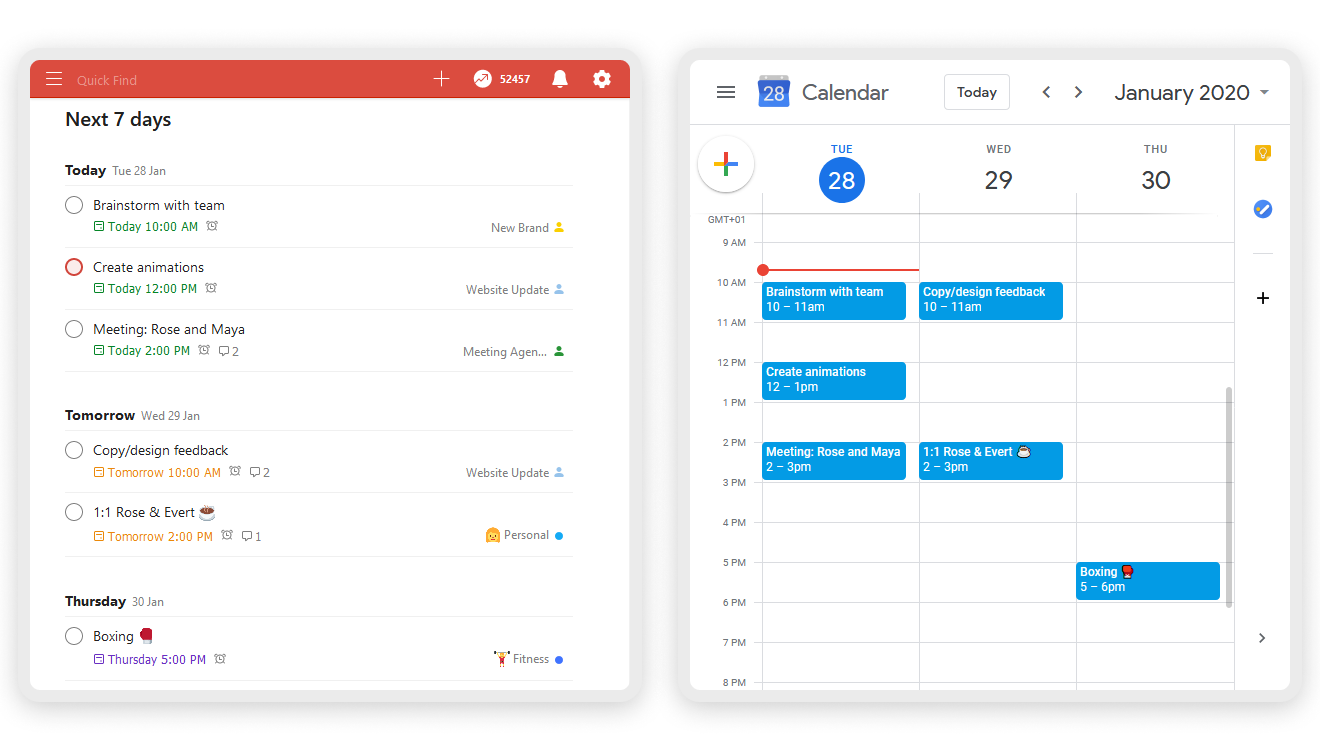
This approach provides power users with the flexibility to use their preferred calendar platform while still keeping upcoming events and tasks in sync.
4. Project Management & Collaboration
A. Project management
Regarding project management, picking a champ between these apps isn’t a walk in the park because they each have their own bag of tricks.
A. Things 3
Things 3 lets you group related projects together into specific areas. Then, in each specific project, you can create sections and headings for better organizing tasks, and attach checklists to your tasks.
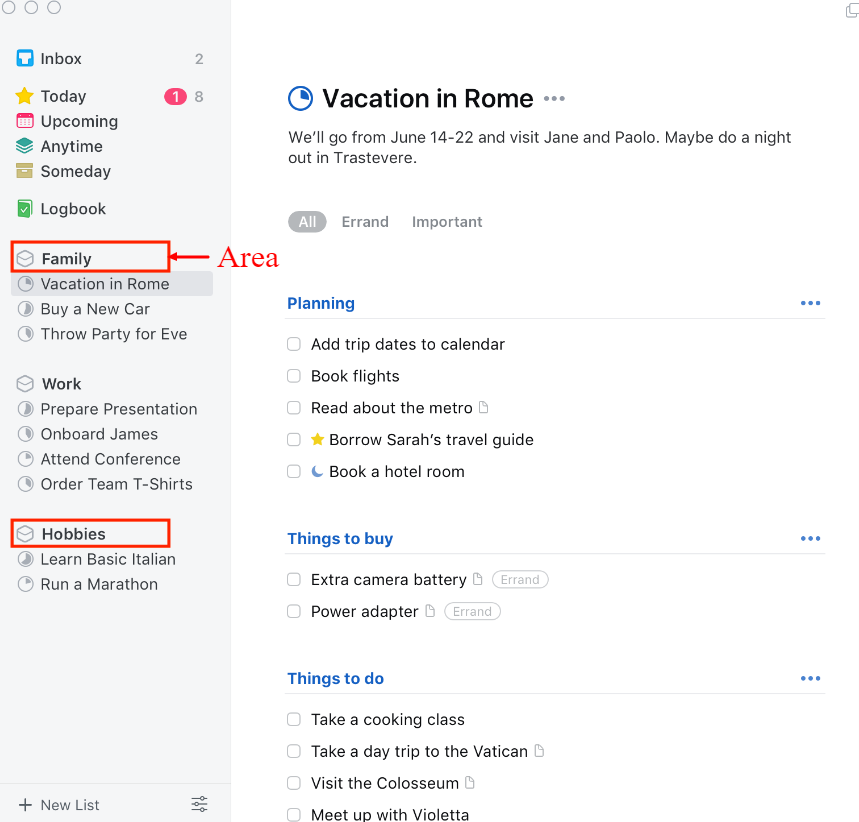
But here’s the thing – traditional sub-tasks aren’t a thing in Things 3. So, if you’re into super-detailed project management, it might not be your jam.
B. Todoist
This task manager takes a different approach.
It supports a four-level hierarchy: Project -> Sub-project -> Task -> Sub-task
In this structure, sub-projects are a helpful organizational level. They allow you to group similar sub-projects under a parent project, keeping your project list clean and straightforward.
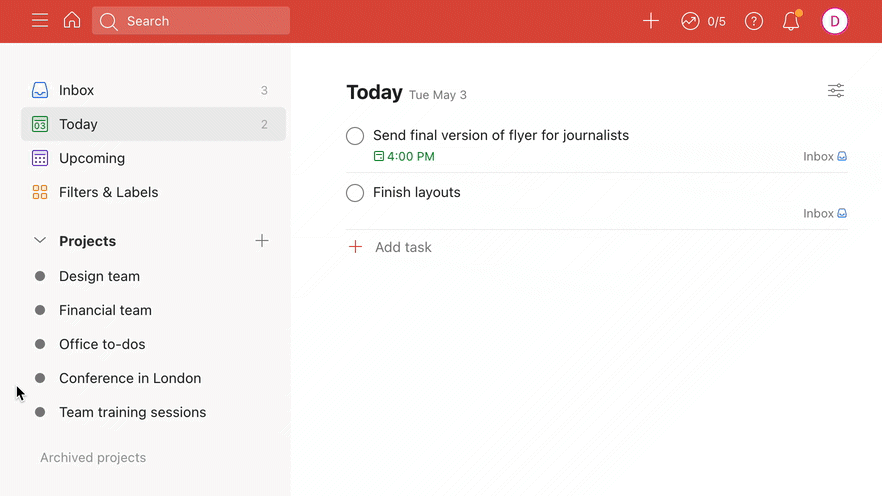
In summary:
- Things 3 offers a structured approach to project management, great for those who want everything organized neatly.
- Todoist, on the flip side, provides a balance between structure and flexibility. It’s suitable for users who want to organize tasks into projects but also need the flexibility to keep things dynamic.
B. Collaboration
Okay, here’s where the real game-changer comes in.
Todoist stands out as the only app in this duo that supports team collaboration. It offers a range of features crucial for team collaboration on projects.
The cool part?
It keeps collaborative projects neatly separate from your personal projects.
In Todoist, you have full control over who can join which of your projects, ensuring privacy and security.
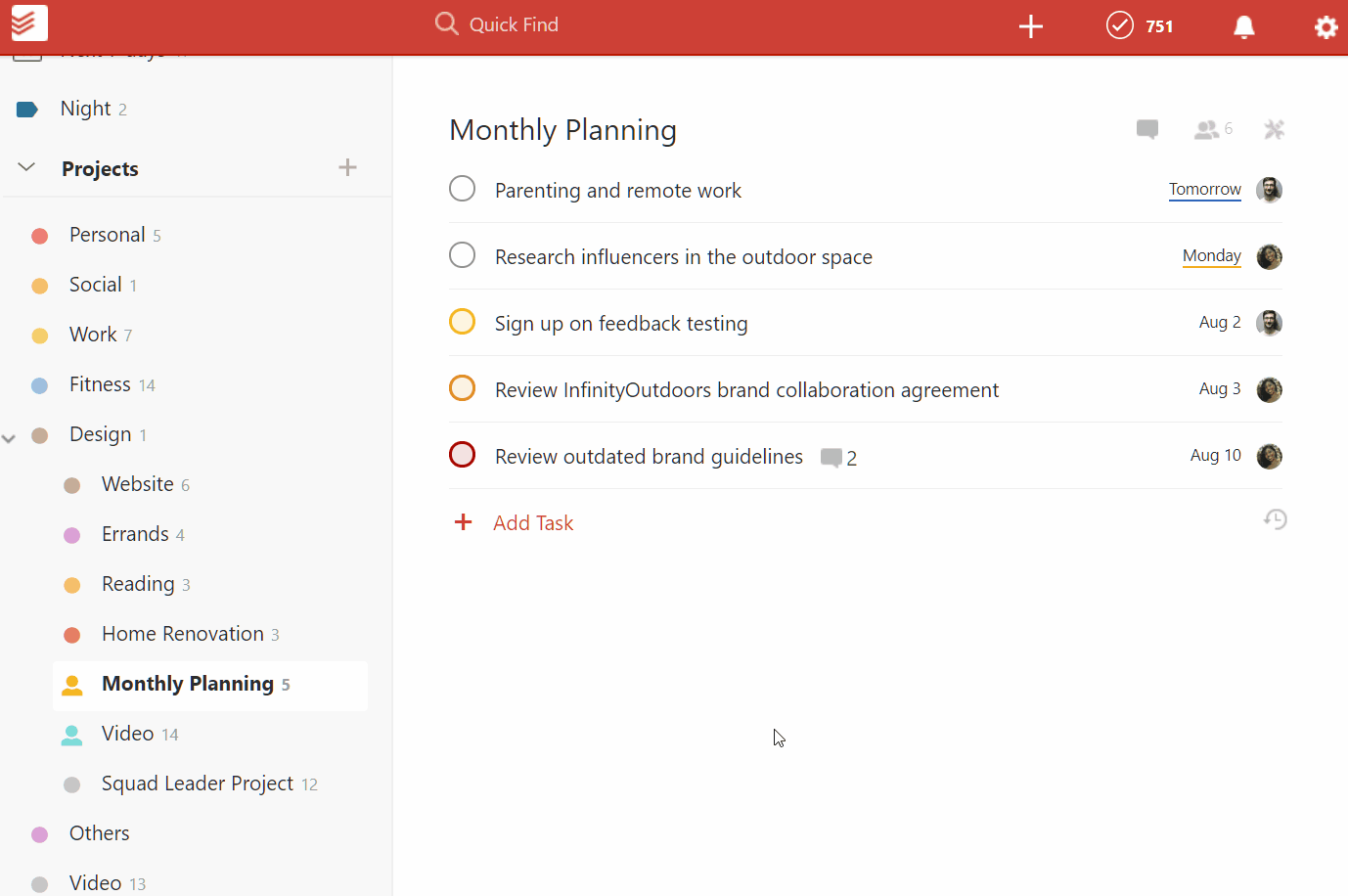
Once your team is on board, you can create notes, tag someone in the comment box, and attach files for smooth collaboration right within tasks.
Plus, Todoist plays nice with major platforms – Android, Web, Windows, iOS, and even Apple Watch – making teamwork across multiple platforms a piece of cake.
But hold on, there are a couple of hiccups in Todoist’s collaboration capabilities:
- It only supports assigning one person to a task.
- Lack of real-time communication capability.
On the other hand, Things 3 is designed solely for individual use. This task manager lacks built-in features for collaboration, and you can’t share or sync tasks with others.
So, if you’re an individual or a team in need of collaboration features, Todoist is your go-to option between these two productivity apps.
But remember, there are fancier alternatives out there if you really want to level up your teamwork game. 🙌
III. Things 3 vs Todoist: Pricing
Time for a little price check! Below, we’ll lay out the costs for both productivity apps:
A. Things 3’s Pricing
Things 3 doesn’t offer a free account; instead, it’s available for separate purchases on Mac, iPad, and iPhone. The good news is that it’s a one-time purchase for each platform—no subscriptions required.
- iPad version – $19.99
- iPhone and Apple Watch version – $9.99
- Mac version – $49.99
B. Todoist’s Pricing
This productivity app offers more flexible pricing options:
Free Plan: Available for both teams and individuals. It offers basic features, perfect for simple task management needs.
Todoist Premium: Priced at $4-$5 per user/month. Designed for power users, this plan gets you many advanced features like location-based reminders, repeating tasks, and themes.
Todoist Business: Cost $6-$8 per user/month. Designed for teams and organizations, this plan offers collaborative features, such as team projects, admin controls, and priority support.
IV. Things 3 vs Todoist: Pros and Cons
In a nutshell, here are the pros and cons of each application:
A. Things 3
Pros:
- Sleek and intuitive user interface.
- Seamless integration with the Apple ecosystem.
- Effective task organization and categorization.
- One-time purchase model, no subscription fees.
Cons:
- No free plan & expensive pricing
- Limited cross-platform availability, primarily for Apple users.
- Lacks collaborative features.
B. Todoist
Pros:
- Free to start & flexible pricing options
- Available across multiple devices and platforms
- Support team collaboration
- Robust NLP capabilities
Cons:
- No start date
- Not support multiple assignees per task
- Advanced features and collaboration tools require paid subscriptions.
V. Todoist vs Things 3 Reddit
On Reddit, the topic “Todoist or Things 3” never cools down.
People there appreciate what each tool brings to the table. Todoist gets a thumbs-up for its collaboration capabilities, while Things 3 is applauded for its simplicity.
But, you know, there’s always a ‘but.’
Some tech-savvy people agree that emptying Todoist’s Inbox is a chore.
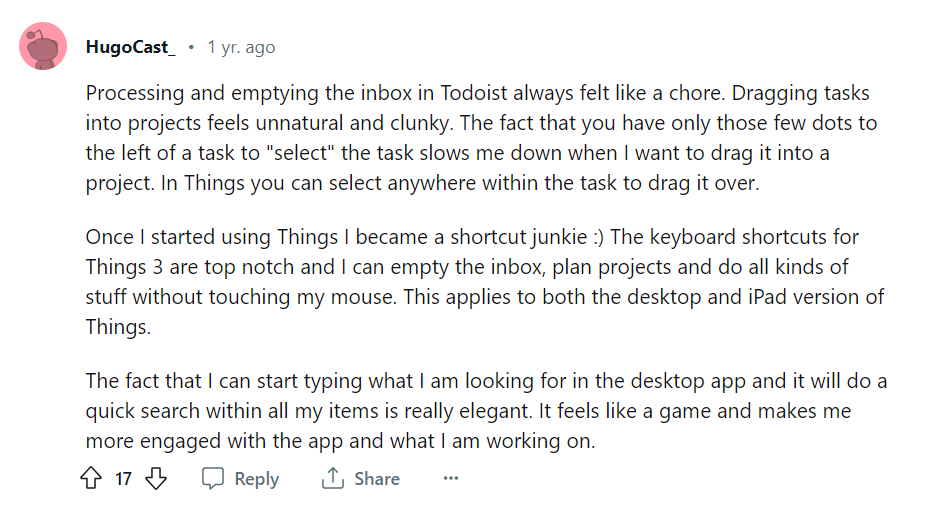
And its lack of start dates is frustrating.

On the other hand, Things 3’s Apple-ecosystem-only compatibility, skyhigh pricing, and lack of collaboration features are deal-breakers for a lot of folks.
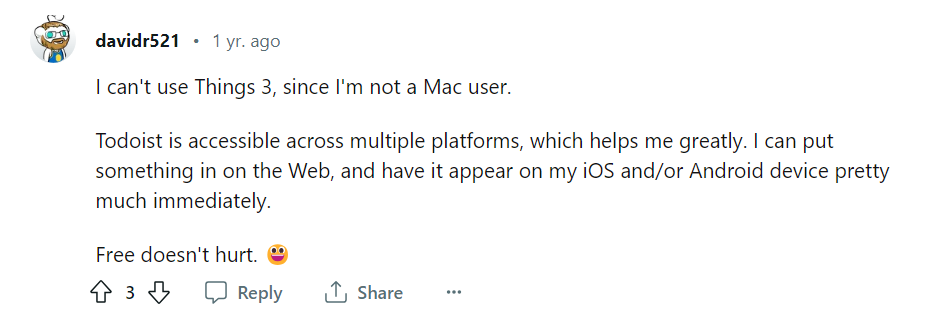

VI. Meet Upbase: The Best Alternative To Things 3 and Todoist
So, you’ve tried Todoist and Things 3, but they just didn’t quite hit the mark for you. You’re in luck because there’s a game-changer in town, and its name is Upbase.
It’s not just another task management app; it’s a powerhouse that takes the best bits of Todoist and Things 3 and sprinkles in a bunch of awesomeness that you didn’t even know you needed.
Here are six reasons why Upbase is worth a try:
1. Robust Task-Planning Capabilities
Upbase’s task-planning capabilities surpass those of Todoist and Things 3.
Forget the basic day and week planning; Upbase lets you plan tasks by the hour, day, week, or month. Its ‘Schedule’ gives you four cool views:
- Daily Planner
- Weekly Planner
- Weekly Calendar
- Monthly Calendar
Plus, Upbase throws in a drag-and-drop feature that turbocharges your scheduling, making it twice as fast.
But here’s the real game-changer: the ‘Daily Planner.’
Imagine having the Today and Upcoming pages of Todoist or Things 3 in one place, along with your overdue task list and an hourly day calendar. Here, you can:
- Adjust the dates and times of overdue tasks
- Create future tasks
- Pull tasks onto the calendar, and tweak their durations.
And wait, there’s more!
Upbase also gives you a recent task list, a Pomodoro timer with ambient sounds to enhance focus, a notepad for quick notes, and a daily journal tool to reflect on your workday.
The cherry on top is you can hide the unused tools to keep the interface clean.
2. Seamless Integration with Google Calendar
Upbase integrates seamlessly with Google Calendar, just like Todoist. You get that nifty two-way sync, so changes in one place show up in the other. You can also connect multiple Google Calendar accounts for added convenience.
But here’s the cool part:
Unlike Todoist which only displays your synced events on the Upcoming view, Upbase displays them across all its calendars. Daily, weekly, monthly – it’s all there.
The icing on the cake is Upbase keeps the original Google Calendar colors for your events. That’s something Todoist can’t touch.
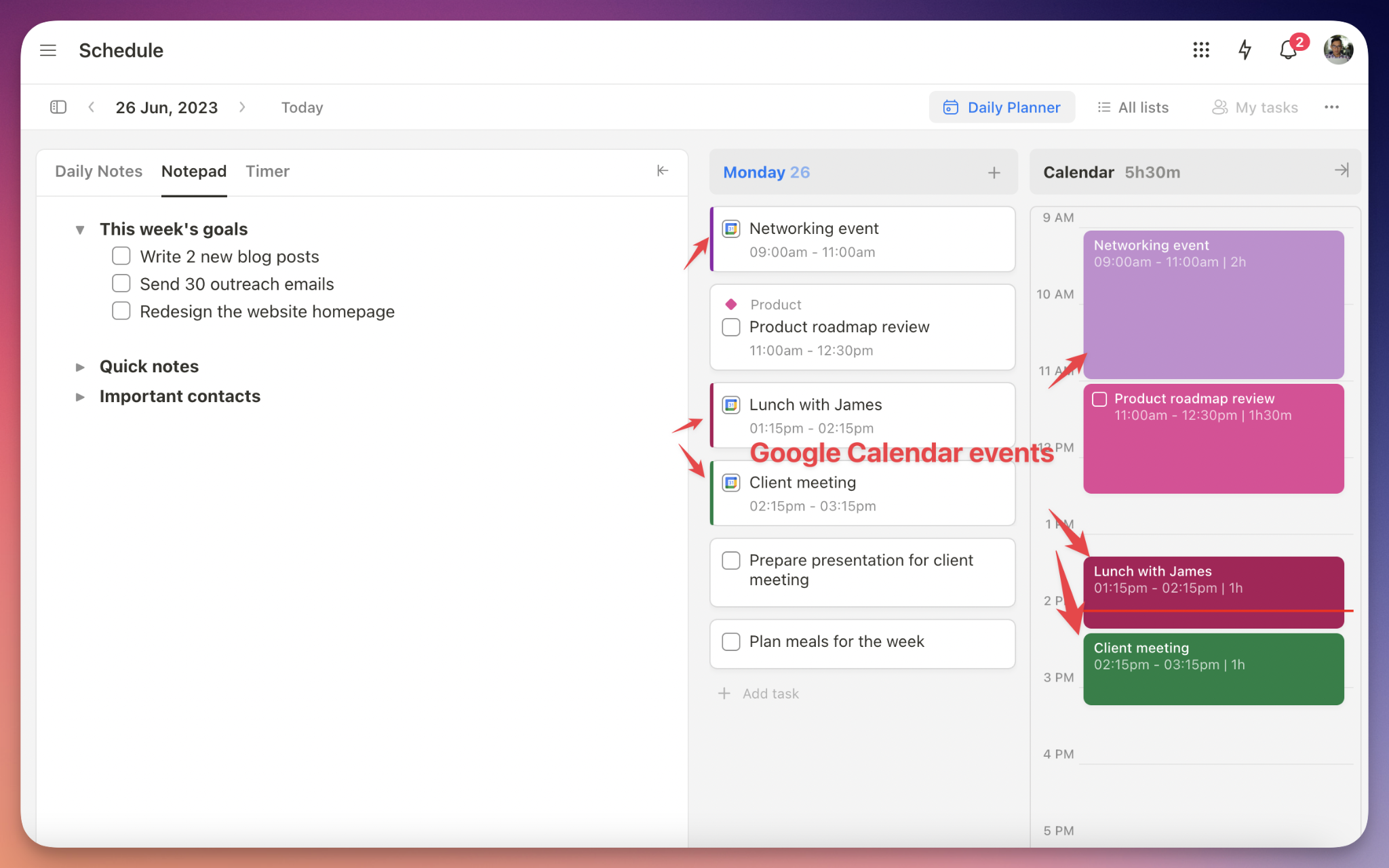
3. Organization
While Todoist and Things 3 are all about organizing tasks within projects, Upbase does it differently – and better.
It brings everything related to a project (tasks, files, docs, schedules, discussions, links, and chats) onto a single page, called “List”.
No more hunting for info; it’s all right there. This smart approach keeps everyone on the same page and boosts productivity.
Want to customize the list interface? Easy-peasy!
4. Enhanced Communication and Collaboration
Upbase excels in providing tools for communication and collaboration that outshine Todoist.
Look at this Upbase vs. Todoist comparison:
|
Feature |
Upbase |
Todoist |
|---|---|---|
|
Collaborators per free project |
Unlimited |
5 |
|
Guest access |
✅ |
✅ |
|
Comments & attachments |
✅ |
✅ |
|
Task assignments |
✅ (multiple assignees/task) |
✅ (one assignee/task) |
|
Subtask assignments |
✅ |
✅ |
|
Real-time messaging: +1:1 chats +team chats +custom group chats |
✅ | |
|
Watchers |
✅ | |
|
Collaborative files, docs, and links |
✅ | |
|
Shared project calendars |
✅ | |
|
Message boards |
✅ |
Key takeaways:
- You can assign members to both tasks and subtasks in Upbase, whereas Todoist supports only task assignments.
- Upbase allows for a single task to be assigned to multiple people at once, whereas Todoist doesn’t.
5. Comprehensive Features with an Intuitive UI
As you see, Upbase offers everything you’d expect from Todoist and Things 3, and many more. But here’s the kicker—it doesn’t get all messy with a complicated user interface.
Nope, Upbase keeps it simple, intuitive, and super easy to handle.
So whether you’re just starting out with task management or you’re a total pro, you’ll find it’s a breeze to use.
6. Generous Free Plan
Unlike Things 3 which drains your wallet faster than you can say “productivity”, Upbase offers a great free plan that lets you have unlimited users, tasks, and storage. It’s perfect for both individuals and teams of all sizes.
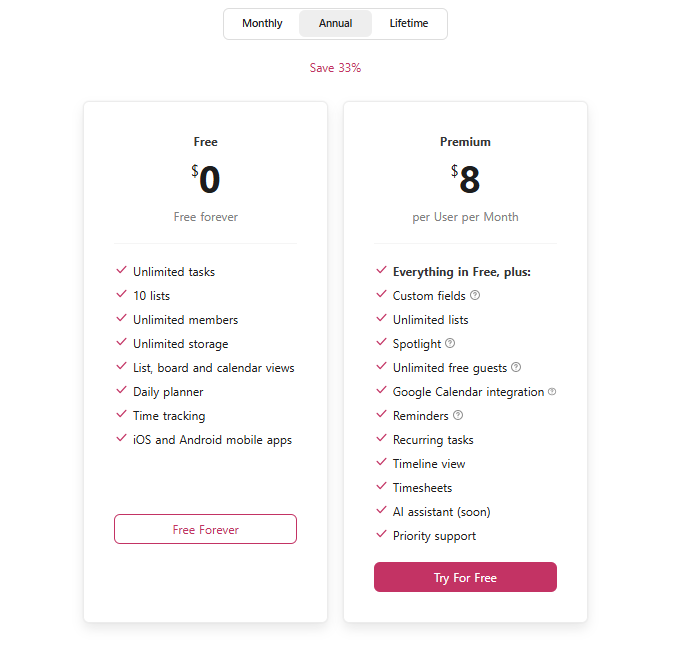
So, if Todoist and Things 3 left you wanting more, Upbase is your go-to alternative.
With its easy-peasy interface, robust collaboration tools, smart project management, flexible task planning, and deep Google Calendar integration, Upbase is the game-changer you’ve been searching for.
Give Upbase a whirl and watch your to-do list turn into a to-done list! 🚀
